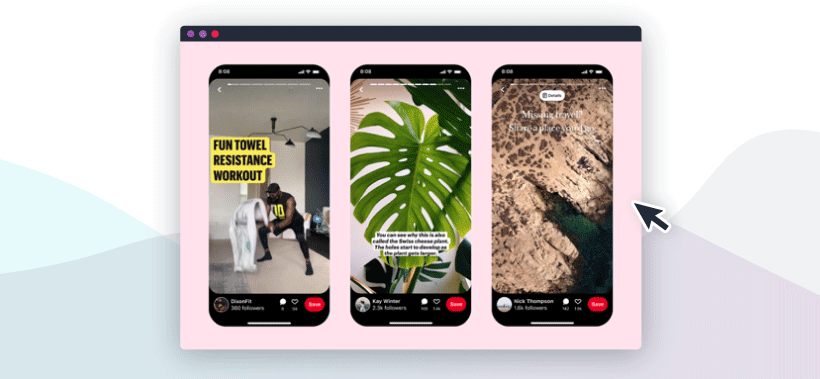Sometime around 2011, I stumbled across Pinterest. They were a startup back then and I was a digital media content editor where producing popular, image-driven photo galleries was one of my orders of the day. Naturally, I gravitated to Pinterest whose image-first format held great appeal for visual inspiration, story ideation and concept development.
This was before Instagram was really a thing… and even Facebook (at the time) was mostly just a place to see photos of “friends” and their families living their best curated lives amid a tidal wave of other random feed flotsam.
Many hours down a Pinterest rabbit hole later, I found myself overflowing with inspiration for stories. Surfing boards targeting my expressed interests left me anything but, well, bored. Stunning travel destinations, outdoor landscape ideas, DIY ideas — it all felt light, fresh, and easy to swipe through. A seductive place to stir the creative juices.
Cut to 10 years later and Pinterest has evolved to become a top “visual discovery engine,” reporting record traffic figures in 2020. It’s no longer a site dominated by women as it was in its early years and has recently taken bolder strides to tell richer, more dynamic stories using select “creators” right now and eventually, presumably, brands.
Tina Pukonen is an industry vet with 15+ years’ experience leading marketing and media strategy for major entertainment brands across movies, TV, home entertainment, streaming platforms and gaming. As the Global Lead, Vertical Strategy & Marketing, Pukonen oversees the entertainment and restaurant verticals at Pinterest.
Amid the recent beta launch for the aforementioned new feature called Story Pins, Pukonen took time to discuss how the Pinterest platform has evolved from a novel digital bulletin board (akin to digital scrapbooking) to a more advanced visual-discovery engine with 400 million+ monthly active users (Gen Z, millennials and more) fueling its growth.
Here’s what Pukonen had to say.
An interview with Tina Pukonen, Pinterest global lead, vertical strategy & marketing, on new features and maximizing Pinterest for brands.
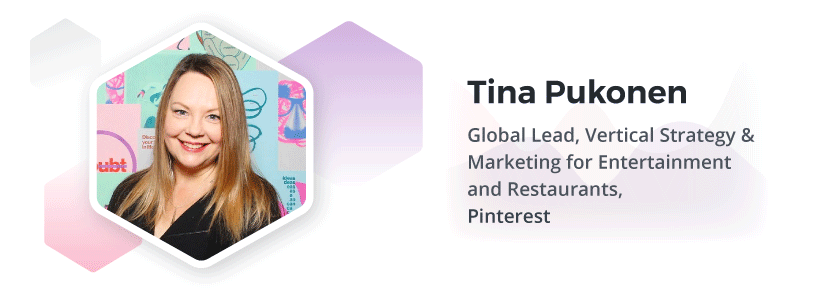
As the third-largest social media platform in the U.S. with 400M+ monthly active users, can you please share what Pinterest is doing that separates you from the rest?
Pinterest is where you go to find ideas that help bring a vision to life, like a dream vacation or a kitchen remodel — to plan for a special moment like a quarantine birthday party or Halloween. And to find solutions for everyday needs, like what to eat for dinner or watch on TV. These are all things I’ve done on Pinterest in the last month. The content that helps people do these things is fundamentally different from other platforms. Pinterest is not where you go to connect with friends and scroll through posts about their past, or to read the latest political news and broadcast your opinions.
That does seem to be one of the more compelling use cases for social media right now…
Pinterest is a place for positivity, which is perhaps more important now than ever. In addition to reaching over 400 million people around the world, our latest research suggests showing up in a more positive environment online drives impact at every stage of the purchase funnel. We just published a white paper, ‘It Pays to Be Positive,’ that goes into more detail about the value of positivity to advertisers and how they can leverage it for their business.
Given the amount of content that exists in the digital world, where does Pinterest hold the greatest value for brands when it comes to creating — and putting out — content that moves people?
One of the most powerful ways to connect with people on an emotional level is by aligning with something they care about. Pinterest is where people go to get inspired, so the interests, passions, hobbies and topics that people engage with are really meaningful and intentional. This generates powerful insights that brands can use to craft content that connects deeply and can play a key role in helping them turn inspiration into a reality. There is no other platform where I routinely save ads from brands so I can come back later and take action on them.
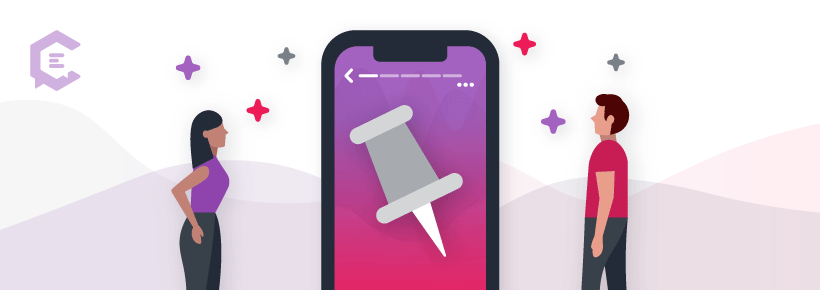
Can you give an example of how Pinterest Story Pins have — or will be — used in your verticals to generate compelling connections with your audience?
I’m excited about Story Pins! Right now, we’re testing Story Pins with creators on Pinterest, as we are always looking for new ways to respond to creator feedback and give them more tools to bring their ideas to a growing audience. The new Pin format enables creators to develop longer-form, long-lasting content with videos, images and text with new editing and publishing capabilities. There are also options to include how-to instructions for ideas like recipes, DIY projects and beauty tutorials.
While our vision is to make Pinterest a platform where anyone can discover and publish great content, we’re limiting access to Story Pins in beta and focusing on making a great experience for Pinners to take action on the ideas they find from creators.
As a “visual-discovery engine” that powers greater SEO, how can companies and those advising them (e.g., social media strategists) best utilize the platform to generate optimal user engagement in an ever-changing world?
Visual discovery is very powerful and critical to inspiring a planning and purchase journey, especially in the early stages when people are undecided about what to buy. You might not be able to describe your style or something you’re searching for in words, but you know it when you see it.
We’ve identified the five dimensions of inspiring creative. It should be:
- Visually appealing to fuel someone’s imagination with possibilities
- Novel, which could be new or a different take on something familiar
- Positive to make people feel good
- Attainable and…
- Actionable
If I’m a content strategist, what am I most excited about when it comes to making Pinterest part of my marketing plan?
We tend to get an earlier read on emerging trends than other platforms because Pinners start planning earlier on Pinterest — we see searches begin weeks or even months earlier than on a popular search engine. This is especially true for seasonal moments and major holidays. For instance, we typically see searches start climbing for the end-of-the-year holidays in July, although this year, holiday searches began in April!
Content strategists can — and do — use these early insights to help shape their marketing campaigns.
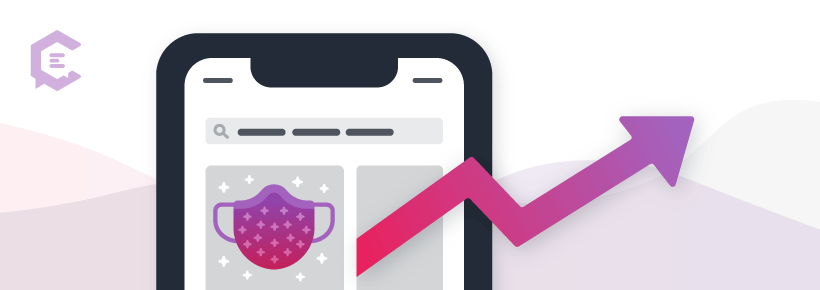
I’m intrigued by how what’s happening in the world gets immediately reflected via searches on social media platforms. For instance, I read on your site that searches for “Blinged out face mask” have surged 57 percent during COVID-19. What do metrics like these say to brands trying to navigate unique times — and how they might utilize Pinterest in terms of pivoting during a pandemic?
We’ve been providing up-to-date weekly insights to advertisers since the beginning of the pandemic. Inspired directly by Pinterest insights derived from consumer behavior, we’ve seen advertisers pivot their messaging to provide direct solutions to problems Pinners were facing. Others have used our insights to inform changes to their creative and messaging. For example, many would not think McCormick, a flavor company, would be the first place to look for indoor activities (which were up 13x early in the pandemic), but they found new creative use cases for their product with this DIY window clings Pin and this sand-slime Pin. These became two of their top saved Pins this year.
How have these uncertain times been reflected in the verticals that you lead — entertainment and restaurants — especially given the closures of movie theaters and restaurants?
It’s been a challenging time for the entertainment and restaurant industries overall, but there has been accelerated growth for in-home entertainment and off-premises dining during the pandemic. We’ve seen this growth reflected in vertical search trends on Pinterest. For entertainment, searches for movies and shows to watch on streaming platforms have more than doubled year over year. Movie night at home has become an event, and Pinners are getting creative looking for ideas for backyard movie nights and drive-in movie dates.
For restaurants, we’ve seen significant increases in people searching for quick and easy meal solutions for every meal of the day, and especially for family meals, which is something restaurants are leveraging with meal deals for takeout and delivery.
Can you please provide a quick snapshot of a success (or two) in your verticals that show how Pinterest may have reinforced its value proposition at a time when marketers pulled back?
We have a really interesting campaign that launched for ‘Selena + Chef,’ Selena Gomez’s new show on HBO Max that is all about cooking in quarantine. To celebrate the launch, people could turn to Pinterest to get an exclusive recipe from Selena and her grandma: the star’s favorite cheesy tortilla chip casserole. The companion video called ‘Cooking with Nana’ was on Pinterest’s Today Tab, a dedicated source of daily inspiration with curated Topics and trending Pins.
Eighty million people engage with food content monthly on Pinterest and 60 million people watch trailers/video and engage with content from entertainment brands like HBO Max every month, so it was a perfect match for those two interests.
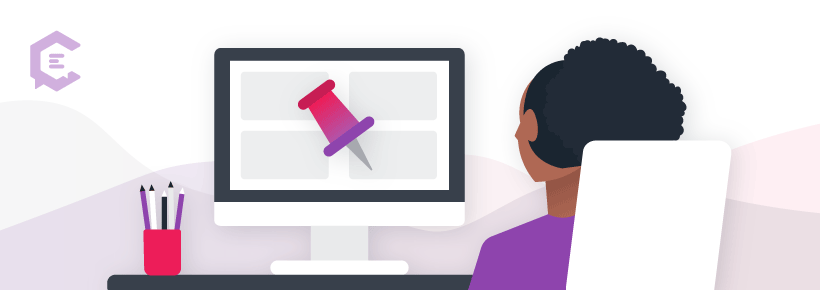
In the realm of pivots, how has Pinterest as a company handled the shift to full-time remote work in 2020? Was it a seamless transition and what surprised you most about how teams responded to being offsite?
With the nature of my role and its global scope, even before the pandemic, I collaborated extensively with colleagues in other offices across the country and around the world, so shifting to working from home full time wasn’t difficult.
Of course, I miss seeing colleagues and clients in person, but I’ve been pleasantly surprised how creative people have been when it comes to finding ways to schedule in team-bonding time, with virtual coffee chats, happy hours, ‘meet your pet’ parties as well as corporate-driven pop-up events around topics including wellness, music, food, art and more.
Was there any extensive use of freelancer teams (aka teamlances) during this unique time or did Pinterest stick with its core workforce and adapt accordingly?
Freelancers and contractors are an incredibly important part of the Pinterest community. They’re integral in helping us grow the company. During the pandemic, we continued to stick with the core workforce and our existing contractors, and didn’t increase this part of our workforce.
Any exciting future roll-outs you can speak to that will expand the power of what creators (and brands) will be able to accomplish on your platform?
In addition to Story Pins in beta, we just launched a new suite of creator-first features that include a new creator profile, analytic tools and an engagement tab. These new features will make it easy for creators to publish content directly to Pinterest, measure performance, and build and interact directly with their audiences.
